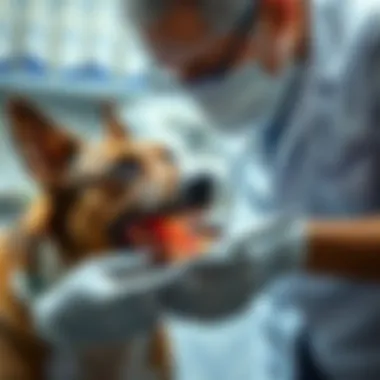Essential Guide to VOHC Approved Dog Dental Products


Intro
Dental care for dogs isn’t just a nice-to-have; it’s crucial for their overall health. Pet owners often overlook this essential aspect while focusing on food or exercise routines. However, just like us, the well-being of our furry friends hinges on clean teeth and healthy gums. Poor oral hygiene can lead to severe health problems, including heart and kidney issues, and nobody wants that.
The Veterinary Oral Health Council (VOHC) plays a pivotal role in addressing these concerns. This organization certifies dental products that effectively combat dental diseases in dogs. Their stamp of approval is not just a fancy logo; it's a badge of honor that signifies that a product genuinely aids in maintaining canine oral hygiene. With numerous options flooding the market, knowing which products meet VOHC standards can save many pet owners a headache and, more importantly, ensure their dogs' health remains intact.
In this guide, we aim to unravel not just the reasoning behind prioritizing your dog's dental health but also the specific products that come highly recommended by the VOHC. This article will dissect various categories of these approved products, elaborate on their effectiveness, and provide safe usage tips for all you dedicated pet parents out there. From chew toys to toothpaste, we aim to encompass a well-rounded perspective of what it means to maintain a clean mouth for your four-legged friend.
So, whether you’ve got a young pup or a wise old hound, this guide is designed to equip you with the knowledge necessary to ensure your dog's dental health is top-notch. Let’s get into it!
Understanding the Importance of Dog Dental Care
Maintaining the dental health of your canine companion is not just an afterthought; it is vital for their overall well-being. Dog dental care is often overshadowed by vaccinations and regular exercise, but neglecting it can lead to serious health issues. Just like how your car won't run properly if you neglect the oil change, a dog's health can take a sizable hit when dental hygiene is overlooked.
Here's the kicker: Poor dental care can lead to periodontal disease, which can cause not only mouth pain but also serious infections that can spread to vital organs. Studies suggest that more than 80% of dogs over the age of three show some signs of dental disease. When bacteria from dental plaque enter the bloodstream, it can jeopardize your dog’s kidneys, liver, and even heart. This connection is crucial, underscoring the need for regular dental hygiene practices as part of your dog's health routine.
The Link Between Dental Health and Overall Well-Being
Dental health directly influences numerous aspects of a dog's overall health. Much like how a tree can't flourish without strong roots, a dog can't thrive with poor oral hygiene. Bad breath, for instance, is often the first sign that dental issues may be lurking beneath the surface. It's not just a minor nuisance; it can signify bacterial buildup that could lead to more serious conditions.
Not only does effective dental care promote fresh breath, but it also encourages healthy gums and prevents tooth loss. Healthy gums serve as a barrier against bacteria entering the bloodstream. Moreover, dental disease can lead to behaviors that owners often misinterpret as "just being a dog." Loss of appetite, lethargy, and irritability can all stem from dental pain.
To further highlight this relationship:
- Heart Disease: Bacteria associated with poor dental health can enter the bloodstream and affect heart valves.
- Kidney Issues: Means maintaining kidney health by reducing the burden of infections spread from the mouth.
In essence, keeping those pearly whites clean can mean fewer trips to the vet and a more joyful, active life for your pet.
Common Dental Issues in Dogs
Several dental issues frequently plague our four-legged friends. Recognizing them can be the first step to prevention:
- Periodontal Disease: One of the most common issues, resulting from plaque buildup on the teeth, leading to sore gums and tooth loss.
- Periodontitis: A more severe progression of periodontal disease that can cause gum recession and bone loss.
- Tooth Fractures: Dogs can fracture their teeth from chewing on hard objects like bones or stones, causing pain and difficulty in eating.
- Malocclusion: Sometimes called a "bad bite," this can alter a dog's ability to chew properly and may cause discomfort.
- Oral Tumors: While less common, growths in the mouth can occur and may require veterinary intervention.
Being attuned to these common issues can allow you to act swiftly; remember, early detection is half the battle. Implementation of a consistent dental routine can go a long way. If you notice any changes in your dog’s behavior, it might be high time to check their mouth.
"An ounce of prevention is worth a pound of cure." - Benjamin Franklin.
Veterinary Oral Health Council and Its Role
The role of the Veterinary Oral Health Council (VOHC) is paramount in the landscape of canine dental care. This organization is dedicated to improving the oral health of our four-legged companions through the endorsement of various dental products. By establishing guidelines and standards for pet dental care, the VOHC plays a critical role in ensuring that pet owners have access to products that are effective and safe for their dogs.
The Purpose of the VOHC
The mission of the VOHC is straightforward yet impactful: to promote better dental health in dogs. This goal is achieved by evaluating and approving products that meet stringent criteria for efficacy in reducing plaque and tartar. When a product carries the VOHC approval, it serves as a stamp of assurance for pet owners. This badge of honor not only indicates effectiveness but also reflects a commitment to science-backed dental care practices.
Pet owners whose dogs suffer from dental diseases can significantly benefit from VOHC-approved products. Regularly using these endorsed options can lead to enhanced oral health for pets, which parallels better overall health in dogs. The VOHC strives to educate both veterinarians and the public on the importance of canine dental hygiene, stressing that preventative care can save both pain and cost down the road.
How Products Are Evaluated and Approved
The evaluation process for dog dental products is meticulous. The VOHC employs a team of veterinary dental experts who scrutinize products based on scientific studies and clinical evidence. Here's a brief overview of how this process unfolds:
- Research Review: The committee reviews existing studies that demonstrate a product's effectiveness in reducing plaque and tartar, among other dental issues.
- Testing Procedures: The VOHC often requires manufacturers to conduct their own studies, following preset protocols to assess the product rigorously.
- Compliance Check: Products must adhere to specific ingredient safety standards and labeling requirements, ensuring they do not contain harmful substances.
- Final Approval: If a product meets or exceeds all criteria, it gets the VOHC Seal of Acceptance, denoting its reliability and effectiveness.
Vigilance in product selection is vital. VOHC-approved items not only safeguard your dog's dental health but also act as reliable resources in managing oral diseases.
With this rigorous evaluation in place, pet owners can rest easy knowing that each VOHC-approved dental product has withstood the test of thorough scrutiny. These steps underpin the organization’s commitment to promoting canine oral health, assuring pet owners that they are investing in quality and efficacy.
Categories of VOHC Approved Dog Dental Products


Understanding the categories of VOHC approved dental products is pivotal for dog owners keen on maintaining their pets’ oral health. Each category serves a unique purpose and offers various benefits tailored to different dental needs. Choosing the right type can mean a world of difference in ensuring your dog has a clean and healthy mouth, ultimately influencing their overall well-being. Therefore, knowing what's available is a critical first step in sustaining effective dental care routines.
Dental Chews and Treats
Dental chews and treats are often a dog’s favorite part of a dental care program. These munchable solutions do more than just please a pup's palate; they can help significantly reduce plaque and tartar build-up. When a dog gnaws on these specially designed chews, they are not only satisfying their natural instinct to chew but are also engaging in a form of dental exercise that promotes gum health. The abrasive texture of the treats scoots away food particles and plaque, clearing away residue that regular brushing might miss.
Some notable options include:
- Greenies
- Nylabone
- Purina DentaLife
While offering these goodies, it’s vital to consider the appropriate size and caloric content. Chewing too small may pose a choking hazard, while choosing those too large may not offer a feasible solution to one's dental woes. It's not just about handing over a treat; it’s about knowing which product best fits your dog’s needs.
Toothpastes and Topical Solutions
This category is undeniably essential when aiming for meticulous dental cleaning. It's important to notice that human toothpaste can be toxic to dogs, so always opt for those specially formulated for canine use. The VOHC-approved toothpastes often contain enzymes or other ingredients that effectively break down plaque while being palatable for dogs. Regular use can lead to improved gum health and fresher breath, making those earlier morning cuddles much more pleasant!
Look for brands such as:
- Vet’s Best
- PetSmile
- TropiClean
Whether it’s a brush or a finger brush you choose, set a schedule. Consistency is key in battling dental issues. Not only does establishing a routine promote better oral hygiene, but it also helps your dog adjust more quickly to dental care practices.
Water Additives and Rinses
Like adding a twist to ordinary dog care, water additives and rinses can play a significant role in enhancing dental hygiene a day without demanding a significant amount of effort. These products are easy to implement—just mix them into your dog's water bowl and watch the magic happen. They are formulated to fight bacteria and reduce plaque build-up with every sip your furry friend takes. Incorporating these products into your dog's daily diet can help maintain fresh breath and overall oral health.
Consider looking into brands like:
- Vet’s Best Enzymatic
- TropiClean Fresh Breath
Such products are especially helpful for pets reluctant to undergo brushing or chewing. However, it remains important to read and heed any usage guidelines to avoid overuse and ensure that the additives are suitable for your dog’s overall health.
Dental Toys
The allure of dental toys is powerful, drawing dogs in for hours of fun while simultaneously promoting dental health. These toys are often designed with textures that clean teeth as your dog chews, and some even contain breath-freshening elements embedded in them. They are a perfect combination of playtime and canine dental care, making it easier for pet owners to engage their dogs in good habits.
Reputable choices include:
- KONG Dental Chews
- PetSafe Busy Buddy
- Zogoflex
Incorporating dental toys into playtime also reinforces good behaviors. Not just a passing fancy, these toys can turn daily chewing into a beneficial dental routine that keeps your dog's teeth sparkling.
By exploring these diverse categories of VOHC approved products, dog owners can prioritize their pets’ dental health while giving them enjoyment and stimulation. It's not just about clean teeth; it's about building habits that contribute to a rich, happy life for our furry friends.
Benefits of Using VOHC Approved Products
When it comes to keeping your dog's mouth healthy, it's a real no-brainer. You want the best for your furry friend, and using VOHC approved products is one effective way to ensure their dental health is in tip-top shape. The Veterinary Oral Health Council (VOHC) designation guarantees certain standards of quality and efficacy for dog dental products. By prioritizing these options, pet owners can not only avoid common dental problems but also promote overall health. Let's delve into the specific benefits these products offer.
Effectiveness in Reducing Plaque and Tartar
One of the leading reasons to consider VOHC approved products is their proven effectiveness in reducing plaque and tartar buildup. Dental plaque is a soft, sticky film of bacteria that can quickly harden into tartar if not addressed. Regular use of suitable VOHC products can significantly hinder the growth of this stubborn build-up, which ultimately leads to healthier teeth and gums.
- Clinically Tested: Many of these products have undergone rigorous testing. This means that they're not just fluff; they genuinely work as advertised.
- Variety of Options: From dental chews to rinses, options are great, catering to different preferences and chewing habits of dogs. So, there’s something for every pup.
Enhancing Fresh Breath
Let’s face it—dog breath can be a bit close to unsavory at times. VOHC approved dental care products can dramatically enhance your pet’s breath. Products that focus on freshening breath often include ingredients formulated to neutralize odors, leading to more pleasant interactions with your four-legged friend.
- Ingredient Might Matter: Look for natural additives like peppermint or chlorophyll to combat foul smells and leave your dog’s mouth feeling fresh. It’s a simple measure that’s worth it.
- Routine Matters: Incorporating these freshening products as part of your pet's routine not only improves breath but also contributes to high-quality oral hygiene.
Promoting Healthy Gums


Healthy gums are vital for your dog’s overall oral health. Inflammation or disease in the gums can lead to serious health issues. VOHC approved products have been designed not just to clean teeth, but also to support gum health. Here’s how:
- Anti-inflammatory Properties: Many dental products include ingredients that can reduce inflammation while promoting circulation in the gum tissue. This action can help your dog avoid painful gum disease.
- User-Friendly: Not sure where to start? Easy-to-apply gels and soothing rinses make it straightforward to include gum care in your pet’s routine.
In summary, VOHC approved products hold the promise of keeping your dog's mouth healthy and happy. The implications go beyond fresh breath; they encompass a more extended commitment to overall well-being.
By investing in these specialized products, you lay the groundwork for improved health, leading to a happier life for your beloved pet. Whether it's just about refreshing breath or safeguarding gums, these choices echo the kind of care they're worth!
How to Choose the Right VOHC Approved Product
Choosing the right VOHC approved dental products for your dog isn't just a matter of convenience; it's about making informed, health-boosting choices for their oral hygiene. With so many options available, it can be overwhelming for pet owners. Moving past mere shelf appeal and flashy packaging, you should focus on how well a product meets your dog's specific needs, ensuring maximum effectiveness in maintaining their dental health.
Identifying Your Dog's Specific Needs
Every dog is unique, right? Different breeds, ages, and health conditions can contribute to varying dental health needs. Here are some key points to consider when identifying what works best for your furry friend:
- Age and Size: Puppies may need softer treats designed for tender gums, while larger, older dogs might benefit from tougher chews that support stronger teeth.
- Pre-existing Conditions: For canines suffering from periodontal disease, finding VOHC approved products specializing in combating bacteria would be key.
- Behavioral Traits: Is your pup a sensitive soul? Opt for gentler solutions, and avoid products that might make them anxious.
Here’s a simple checklist to help you identify your dog’s dental health needs:
- Check your dog's age and size.
- Assess any existing dental conditions.
- Observe their preference in textures and flavors.
- Look for VOHC marked options that match these observations.
Remember: The right dental product can enhance not only health, but also your dog’s overall happiness.
Consulting with Veterinary Professionals
Consulting a veterinarian is one surefire way to feel confident about the choices you make. Their expertise ensures you’re not just guessing but are making educated choices based on your dog's individual health. Here’s how to make the most of that consultation:
- Bring Dental History: Share any previous dental issues your dog has suffered from, even if they seem minute. Little things can create big pictures.
- Ask for Recommendations: Don't hesitate to specifically ask about VOHC approved products that are suitable for your dog's circumstances. This could narrow down the multitude of choices significantly.
- Regular Updates: Regular health checks allow for timely discussions about transitioning to new products or adjusting routines as your pet ages.
You might be surprised, too, that many vets have personal experience with different products; they can share what worked well for their own pets.
In summary, by understanding your dog's specific needs and seeking guidance from veterinary professionals, you significantly increase the chances of selecting the most effective VOHC approved dental products. Taking these steps not only enhances your pet's dental health but also fosters a stronger bond between you and your furry friend.
Safe Usage Guidelines for Dental Products
When it comes to ensuring your dog's dental health, knowing how to use dental products safely is paramount. While VOHC approved products are formulated with your pet's well-being in mind, there are a few key considerations to keep in mind that can significantly enhance their effectiveness and your dog's overall experience. Identifying and adhering to safe usage guidelines can make all the difference in establishing a routine that supports long-term oral health.
Recommended Frequency of Use
It's essential to establish a routine that aligns with your dog's specific needs. The recommendation here is not a one-size-fits-all scenario. Generally, you want to incorporate dental products daily or a few times a week, depending on the type of product and your dog's individual dental condition.
- Dental Chews and Treats: These should be offered daily for optimal results, as they are designed to combat plaque and tartar as your dog chews.
- Toothpaste: Brushing your dog's teeth at least two to three times a week can help remove plaque before it turns into tartar.
- Water Additives: These can supplement your dog's drinking regimen. Daily use paired with adequate hydration can help maintain oral hygiene.
Always read the product guidelines and consult your vet regarding any products you introduce. They can provide tailored advice based on your dog's health and habits.
Examination of Ingredients
Before you go reaching for that dental product, taking a closer look at its ingredients is vital. Just like you wouldn’t consume something without checking what’s in it, the same goes for your furry friends.
- Natural Components: Look for products that use natural ingredients and avoid ones harboring artificial preservatives, colors, or flavors. For instance, some dental chews may contain chicken fat or sweet potato, which are generally more digestible.
- Safety First: Ingredients like xylitol can be toxic to dogs, so ensure that it’s not present in any products you choose.
- Recommended Additives: Some products may contain beneficial natural ingredients such as green tea extract or aloe that can enhance oral health.
A comprehensive examination of ingredients will not only keep your dog safe but also assure that you’re investing in their well-being.
Monitoring Your Dog's Reaction
Once you’ve introduced a new dental product into your dog's routine, it’s crucial to keep a watchful eye on how they respond. Each dog is different, and monitoring their reaction helps gauge if the product is a good fit.
- Physical Signs: Look for any signs of discomfort, such as excessive drooling, gagging, or refusal to eat when a new product is being used.
- Gum Health: Check for any signs of redness or swelling in their gums, as this can indicate irritation or an allergic reaction.
- Behavior Changes: If your typically jovial pup seems off after starting a new dental regimen, it might be time to reassess the product.
Regular observation will help you catch potential issues early, ensuring a happy, healthy pup while on their dental journey.


The Process of Introducing Dental Products
Integrating dental products into your dog’s routine is not just about slapping a toothbrush in their mouth and calling it a day. It's about creating a thoughtful approach to ensure your canine companion accepts and, over time, benefits from these dental care practices. Here, we delve into the intricacies of this process, emphasizing its importance and effectiveness in promoting your dog's oral health.
Gradually Incorporating Dental Health Routines
The key here is to take baby steps. Start by observing your dog's current habits, preferences, and any past experiences related to dental care. This foundation will guide how you incorporate new products into their lives.
- Start Slow: Begin with one product at a time. For instance, if you wish to introduce a dental chew, let your dog become familiar with that before advancing to brushing. little by little they'll adjust.
- Routine is Vital: If you establish a consistent schedule for dental cleaning, it becomes just another part of their daily life. Dogs thrive on routine, so choose a time that works best for your pet.
- Watch Responses: Pay attention to how your dog reacts during the introduction phase. If they seem uninterested or a bit anxious, reassess and adjust. Sometimes it's best to dial back the intensity and ease into it.
Remember, the goal should not be a military operation but a gentle acclimation to a new norm that will help your dog thrive.
Associating Products with Positive Experiences
Creating a positive association with dental products can make the difference between a dreaded chore and a much-loved activity. How do you ensure each session ends with a wagging tail instead of a sulking pup?
- Use Treats: Reinforce good behaviors by offering a treat after a successful dental routine. This makes it clear that oral care is rewarding.
- Playtime as a Reward: If your dog enjoys play, tie them into the routine. After a dental session, engage them in their favorite game. It reinforces that taking care of their teeth leads to fun times.
"When dogs associate dental care with happiness, they’re more likely to cooperate and enjoy the process."
- Get Involved: Sometimes, simply being around helps. Stay close, talk to your pet in a soothing voice, and build a narrative that this is a moment you share together. Your attitude can greatly influence their perception.
Positive reinforcement transforms any daunting task into a moment of bonding, ensuring both you and your dog look forward to those dental care sessions.
Combining Dental Care with Regular Veterinary Visits
Dental care at home is essential, but coupling it with regular veterinary visits can create a robust strategy for maintaining your dog’s oral health. These visits shouldn't just be routine vaccinations or check-ups; they’re an opportunity to get professional insight into your pet’s dental needs. Vets are trained to spot issues that might go unnoticed at home. Not just plaque or tartar buildup, but more serious concerns, like gum disease or tooth decay, which can lead to pain and other health problems.
When you sync your dog's dental care routine with veterinary visits, you ensure that you're not just fighting the battle against bad breath but also defending against systemic health issues. Here are the primary advantages of professional dental evaluations:
Regular veterinary dental check-ups can prevent small problems from escalating into significant health concerns.
Importance of Professional Dental Check-Ups
Professional dental check-ups provide several benefits. By evaluating your dog’s oral cavity, the vet can identify tartar buildup or receding gums early, significantly increasing the chances of successful intervention before the problems worsen. Here are some important points to note:
- Early Detection: Just like how we go to the dentist for cleanings and evaluations, your dog needs the same. Vets can pinpoint early signs of dental disease, which might be subtle in canines.
- Comprehensive Diagnostics: A vet eyes way more than just teeth. They also assess overall gum health, oral lesions, and any peculiarities that could lead to complications.
- Professional Cleaning: Depending on what the vet finds, they may recommend a professional cleaning. This is vital in reaching those tricky spots that regular toothbrushes cannot.
- Advice & Recommendations: Further, your vet can recommend dietary adjustments or suitable products to bolster your at-home dental care routine.
Signs That Require Immediate Attention
Knowing when to seek professional help is paramount in maintaining your dog’s oral health. Be aware of the following signs:
- Bad Breath: A sudden change in breath odor may suggest serious underlying conditions and not just typical doggie breath.
- Difficulty Eating: If your dog is hesitating or unwilling to chew, it might indicate pain, which is a red flag that deserves immediate attention.
- Excessive Drooling: While some drooling is normal, a sudden increase can signal dental issues.
- Swollen Gums or Bleeding: This shouldn't be taken lightly—swollen or bleeding gums can indicate periodontal disease.
- Behavior Changes: If your dog is unusually irritable or shows changes in overall behavior, their dental health could be a concern.
Ending: Commit to Your Dog's Dental Health
As we wrap up our comprehensive examination of VOHC approved dog dental products, it becomes quite clear: committing to your dog's dental health is not just a choice, but a necessity. This commitment encompasses various elements, from understanding the impact of dental hygiene on overall health to incorporating routine care into your pet's daily life.
Building a Lifelong Routine
Establishing a lifelong regimen for dental care ensures your pet enjoys a robust and healthy life. Just like humans, dogs benefit from consistent oral hygiene practices. Regular brushing, the use of approved dental treats, and routine check-ups go a long way in preventing the onset of severe dental issues, such as periodontal disease or tooth loss.
- Daily Brushing: If you can make tooth brushing a daily habit, do it! Get your pooch used to the process. Make sure to use a toothbrush and toothpaste specially crafted for dogs. The trick is to keep it light and easy, so your dog grows fond of the routine rather than despising it. You might want to try different flavors until you find one that gets their tail wagging.
- Dental Treats: Consider incorporating VOHC approved dental treats in your dog’s diet. These treats not only help in scraping off plaque but also make the process enjoyable for your furry friend. It’s like rewarding them for taking care of their teeth!
- Routine Vet Visits: Make sure to schedule regular visits with your veterinary professional. They can identify many problems early on, helping you avoid larger issues down the road. Think of these visits as routine check-ups for your four-legged companion, rather than isolated incidents.
By weaving these practices seamlessly into your dog’s life from an early age, you’re laying the groundwork for a healthy future. It’s important to remember that a healthy mouth contributes significantly to your dog’s overall well-being.
Encouraging Others to Prioritize Dental Care
Beyond your own pet, there’s a world brimming with canines whose owners may not yet fully understand the weight of dental health. Spreading the word about VOHC approved products and the significance of canine dental care can be a vital part of fostering healthier pets everywhere.
- Sharing Knowledge: Take the initiative to share your insights with other dog owners. Whether you chat with fellow dog enthusiasts at the dog park or engage in discussions on online forums, your experiences can offer invaluable guidance to those just beginning to prioritize their dog’s dental health.
- Social Media Advocacy: Use social media platforms to advocate the benefits of VOHC endorsed products. Posts that showcase your dog happily munching on a dental chew or showing off those pearly whites can inspire others to pay attention to this essential aspect of pet care.
- Community Awareness Programs: Consider collaborating with local veterinary clinics or pet care stores to host informational sessions or workshops focused on dental care. Connecting with your community benefits everyone, and you could create a network of informed dog owners committed to enhancing their pets' health.
By encouraging fellow dog lovers to see the value in maintaining dental hygiene, you contribute to building a culture of health consciousness among pet owners. A little education can lead to a ripple effect of better dental health for dogs everywhere.
“Taking care of a dog’s teeth is akin to investing in a happier and healthier life for them. A small effort today can mean a world of difference tomorrow.”
In closing, dedicating time and resources to your dog’s dental health speaks volumes. It’s not merely about preventing bad breath or tartar buildup; it’s about ensuring your pooch leads a long, full life. Let's rally together and make that commitment, not just for our own fur babies, but for all dogs who rely on us for their well-being.







